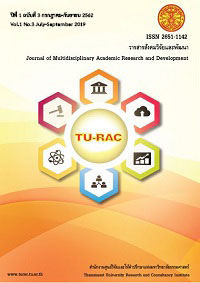US Strategy towards China in the 21st Century
Keywords:
US StrategyAbstract
In the Post-Cold War era, U.S. governments, Bush administration and Obama administration have the same grand strategies. It is the strategy of hegemony. But the rise of China will transform China to be the largest economy in the world. Therefore, in the past, U.S. strategy towards China is the strategy of loose containment, with the mix of two strategies: containment and engagement. However, Trump administration formulates a new strategy towards China with the emphasis on hard containment and disengagement. Trump sees China as no.1 enemy and a threat. China is the main cause of American decline. Trump promises to “Make America Great Again” by trying to contain China. Trump declares trade war with China and announces the policy attacking China which is unprecedented since the end of Cold War.
References
2. ประภัสสร์ เทพชาตรี. (10-16 มิถุนายน 2548.) จีน: คู่แข่งของสหรัฐฯในศตวรรษที่ 21(1). สยามรัฐสัปดาห์ วิจารณ์, ปีที่ 52 ฉบับที่ 3.
3. ประภัสสร์ เทพชาตรี. (2 สิงหาคม 2561). สงครามการค้าโลก (ตอนที่3) , ไทยโพสต์. สืบค้นจาก https://www.drprapat.com/สงครามการค้าโลก-ตอนที่-3/
4. ประภัสสร์ เทพชาตรี. (20 ธันวาคม 2561.)สงครามการค้าโลก (ตอนที่ 4), ไทยโพสต์. สืบค้นจาก https://www.drprapat.com/สงครามการค้าโลก-ตอนที่-4/
5. ประภัสสร์ เทพชาตรี. (6 ธันวาคม 2561).Trump กับยุทธศาสตร์ Indo-Pacific, ไทยโพสต์. สืบค้นจาก https://www.drprapat.com/ Trump-กับยุทธศาสตร์-Indo-Pacific/
6. ประภัสสร์ เทพชาตรี. Obama ประกาศนโยบายทหารต่อเอเชีย ปี 2011. คอลัมน์ โลกปริทรรศน์. สืบค้นจาก https://www.truelife.com/old/detail/382713
7. ประภัสสร์ เทพชาตรี. (9 -10 กันยายน 2553). ความขัดแย้งจีน-สหรัฐ ปี 2010,” สยามรัฐสัปดาห์วิจารณ์, ปีที่ 57 ฉบับที่ 50.
8. Bert, W. (2003). The United States, China and Southeast Asian Security. Palgrave Macmillan.
9. Khalilzad, Z., et. al. (1999). The United States and a Rising China, California: Rand Corporation.
10. Nathan J. and R. Ross. (1997). The Great Wall and the Empty Fortress. New York, NY: W.W. Norton & Company.
11. Christoffersen, G. (1996, November). China and the Asia-Pacific. Asian Survey Vol. 36
12. Donnelly, T. and C. Monaghan. (2007). The Bush Doctrine and the Rise of China,” National Security outlook AEI online, April 30.
13. Drysdale, P. (2011). China, economic containment and the TPP. East Asia Forum, December 12.
14. Economy, E. (2005). China’s Rise in Southeast Asia: Implications for Japan and the United States. The Council on Foreign Relations. Vol3, October 12.
15. Kugler, J., et. al. (2001). Power Transitions and Alliances in the 21st Century”, Asian Perspective, 25 no.3.
16. Ross, R.S., (ed.). (1995). East Asia in Transition. Armonk N.Y.: M.E. Sharpe.
17. Roy, D. (2003, Winter). Rising China and U.S. Interests: Inevitable vs. Contingent Hazards.Orbis.
18. Soon-Bum Ahn. (2001, September). China as Number One. Current History.
19. Tkacik, J. (2006). Hedging Against China. Backgrounder, April 17.
20. China’s appeal overshadows US. (2004, 29 June). The Nation, 6B.
21. The Office of the United States Trade Representative (USTR). (2018). 2018 Special 301 Report.
22. U.S. Government. (2009). Remarks of President Barack Obama, Suntory Hall, Tokyo, Japan, November 14.
23. U.S. Government. (2018). Remarks by Vice President Mike Pence on the Administration’s Policy Toward China, The Hudson Institute Washington, D.C., October 4.
24. U.S. Government. (2017). National Security Strategy of the United States of America.Washington, D.C. : The White House, 2017.
25. U.S. Government. (20118). Remarks by Vice President Pence at the 2018 APEC CEO Summit Port Moresby, Papua New Guinea, Pacific Explorer Marquee Theatre Port Moresby, Papua New Guinea, 2018.
26. U.S. Department of Defense. (2007). Military Power of the People’s Republic of China 2006. Annual report to congress, Pursuant to the National Defense Authorization Act Fiscal Year 2007.
27. U.S. Department of Defense. (2009). Military Power of the People’s Republic of China 2009. Annual report to congress, Pursuant to the National Defense Authorization Act Fiscal Year 2009.
28. U.S. Department of Defense. (2010). Military and Security Developments Involving the People’s Republic of China 2010. Annual report to congress, Pursuant to the National Defense Authorization Act for Fiscal Year 2010.
29. U.S. Department of Defense. (2018). Retrieved from https://dod.defense.gov/Portals/1/Documents/pubs/2018-National-Defense-Strategy-Summary.pdf
30. Binder. (2018). President Trump signs NDAA, banning government use of ZTE and Huawei technology. Retrieved from https://mashable.com/article/ndaa-zte-huawei-ban/#CB7XopmPymqt



